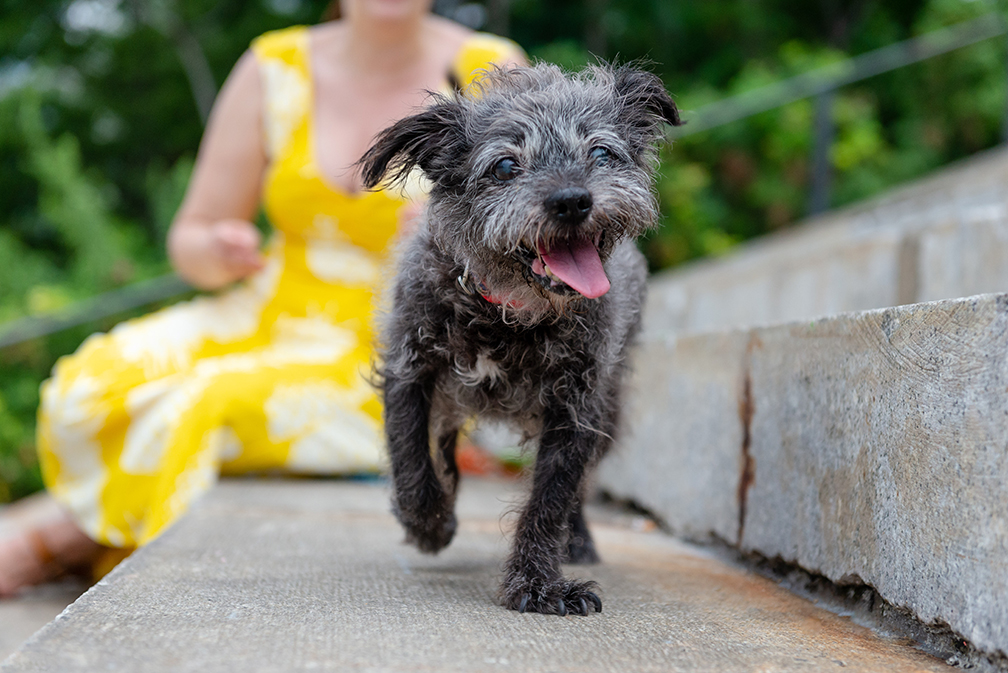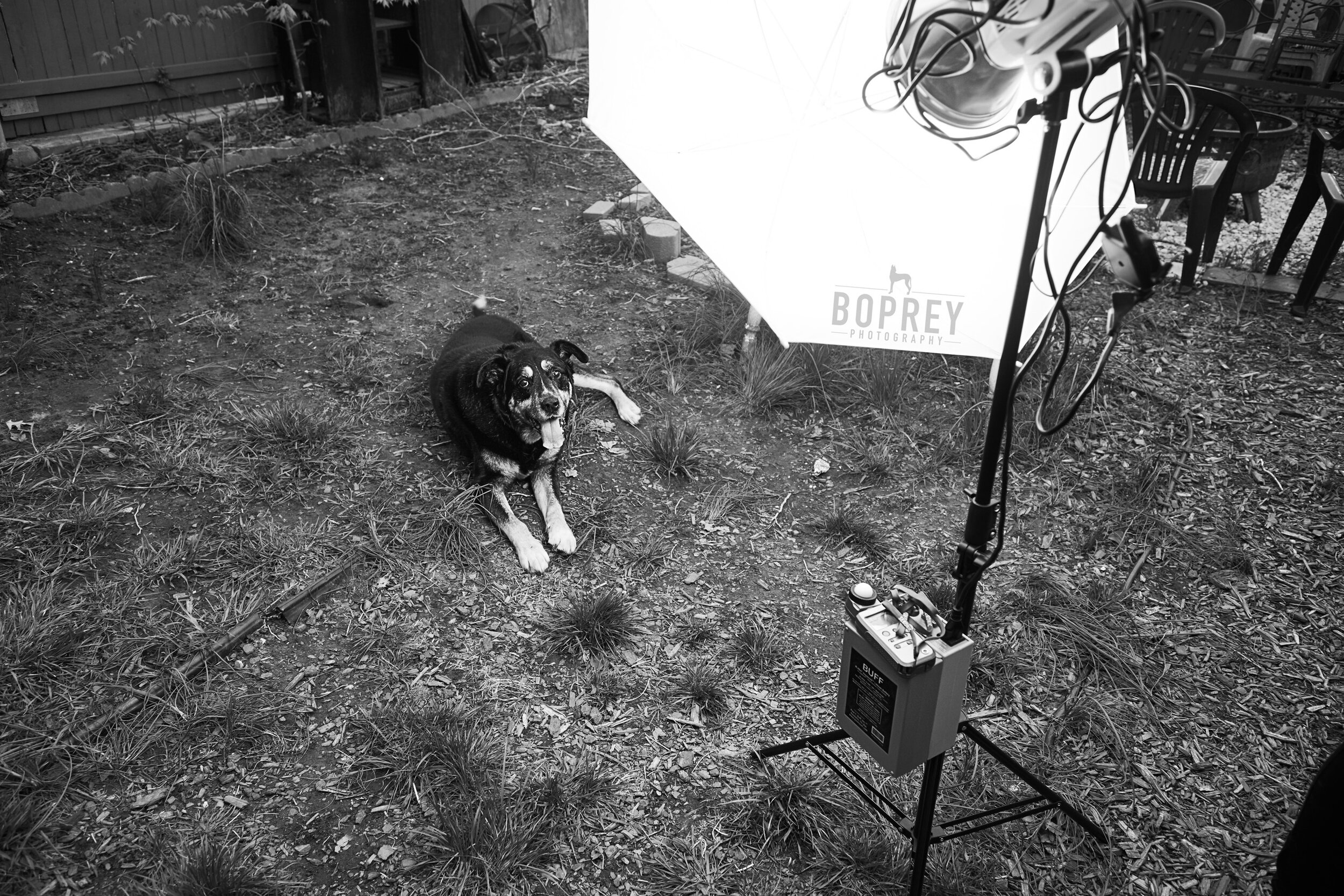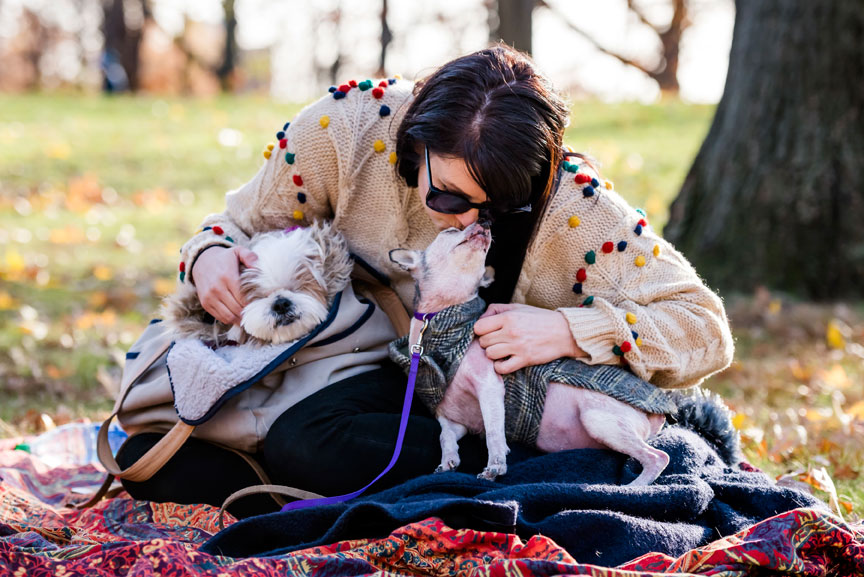Specialized programming, education, and community-building for foster hospice caretakers, rescuers, and their animals.
The term “Fospice” comes from a combination of “foster” and “hospice,” originally adapted from an ASPCA program of the same name. This special kind of fostering finds loving homes for super-senior or terminally ill homeless animals, so that they can live out the rest of their days happily and comfortably. Prior to this special kind of fostering, many Fospice animals would be prematurely euthanized or would spend their remaining time stuck in a cage. With Fospice, these animals can now spend their remaining days in dignity, comfort, and support, receiving treatment similar to palliative care for humans. The goal of palliative care is to address the side effects of aging or illness, and to focus on pain management and comfort rather than treating the progression of disease or decline.
In short: The focus of Fospice care is on the animal’s comfort level, rather than the caretaker’s desire for the animal to live a long time.
Since its founding in 2013, the Foster Dogs Fospice program has sponsored over 70 dogs and cats from more than 30 different rescue organizations. The program was renamed to “Chloe’s Fospice Friends” in 2018 in memory of our biggest supporter and advocate, Chloe Kardoggian of @the_kardoggians. To see just some of the lives we’ve touched, visit #ChloesFospiceFriends on Instagram.
Foster Dogs’ Executive Director Sarah Brasky talks “All About Fospice”
For individuals interested in becoming a fospice parent
+ Is Fospice right for me?
While an incredibly rewarding and life-changing experience, becoming a Fospice caregiver can also have intense moments. Depending on the needs of a particular animal, Fospice may require that you feed them medications orally, provide injections, clean up after instances of incontinence, or make accommodations for special needs. Fospice caregivers receive support from the shelter or rescue organization that they are fostering from in the form of financing medications and care as well as making medical care oriented decisions.
A great fospice parent needs compassion, patience, and flexibility. Many describe it as a uniquely fulfilling experience. Be open and honest with the animal’s rescue organization about your home, lifestyle, and comfort level with different treatments. They will do their best to match you with an animal whose needs are compatible with your circumstances.
+ How do I get started?
To get started on your Fospice journey, contact your local shelters and rescue organizations to inquire about programs they may already have in place. If they do not have a Fospice program already but are open to starting one, you can offer to be a pilot of the program! To help shelters and rescues get started with Fospice, refer them to our Fospice guide right here on fosterdogsnyc.com/fospice.
Join the Foster Dogs’ Fospice Forum support group on Facebook to stay up to date on resources and ways to get involved in the community.
+ How do I create the best home for my Fospice pet?
Just like other foster pets, Fospice animals need fresh air, food, loving company, and a space to call their own. No matter how long your Fospice pet has left to live, by opening your home to them, you are already providing a better experience than they would have had in a shelter.
Fospice pets likely require more time and attention than their adoptable counterparts. They may have physical limitations, signs of senility, or need regular medication. They may also require more monitoring and vet visits. Despite this additional involvement, as Foster Dogs volunteer Leslie Harris noted, ”these dogs will teach you patience, mindfulness, and unconditional love.”
+ How do I best care for my Fospice pet?
Caring for a Fospice pet might be a completely new experience for you, or perhaps you’ve cared for your own animals in their final moments. Either way, it’s good to think about how to know when your Fospice pet is in distress, or when they might just need some extra comforting. Depending on their prognosis, these pets require varied levels of care, sometimes as simple as a semi-annual check-up and arthritis meds.
Common illnesses in Fospice pets include cancer, kidney disease, heart disease, and canine cognitive disorder (often known as canine dementia). Work with your foster organization/shelter and the veterinary care team to identify the best plan to keep them comfortable. Aside from their individual care needs, it is important to watch for signs of pain and distress. Those signs can include:
- Changes in appetite, anxiety, aggression, or sleep patterns
- Unusual responses to familiar people or pets
- Shifting their weight or limping
- Changes in activity levels
- Restlessness
- Panting, trembling, or shaking
- Excessive licking or vocalizations
It is also important to look for signs of anxiety, as it can be distressing and potentially a sign of canine dementia. Signs of anxiety typically worsen at night and can include:
- Panting
- Pacing
- Whining
- Crying
If your pet experiences any of these symptoms, it is important to communicate with the foster organization/shelter and the veterinary care team. As Fospice is centered around compassionate care, pain and anxiety in the animal should be addressed as quickly as possible.
+ How do I ensure my Fospice pet has a good quality of life?
As pets age or progress in an illness, their day-to-day life will change. Be patient with your dog or cat as they may experience physical limitations, changes in their food preferences, or incontinence. Try to keep them as comfortable as possible. Provide them a soft, warm space, surrounded by their favorite things. If they show a disinterest in eating, try varying their food, feeding them by hand if necessary. And if they have issues with incontinence, diapers and belly bands (for male dogs) can be helpful. Wee wee pads or waterproof blankets, made with diaper materials and fleece, can also be easily changed and laundered. If your Fospice pet has a terminal illness, a little research will help you prepare and possibly save some confusion when the disease progresses.
Worried that you won’t know how to evaluate when your fospice pet is near the end? Quality of life changes over time, and what was true for the dog or cat in their early stages might not stay true once their age or illness progresses.
Here are a few tools we recommend. The 5H’s 2M’s scale, developed by Dr. Alice Villalobos, is widely used and a great rule-of-thumb for helping yourself be your fospice pet’s best advocate.
The scale assesses quality of life based on:
- Hurt- the amount of pain your pet is in, including any difficulty breathing
- Hunger- getting adequate nutrition; malnutrition can develop quickly, so keep an eye on this
- Hydration- dogs should consume about 10 mL of water per pound per day (or about 1 cup for a 25-lb.dog).
- Hygiene- dogs should be brushed and cleaned. If they are experiencing incontinence, this will require more attention
- Happiness- does the pet still have wants and needs? Do they react to stimuli?
- Mobility- this is very relative as with larger dogs, it is more important that they be able to move on their own. It is also important to consider if the pet is alert and responsive.
- More Good Days Than Bad- bad days include vomiting, nausea, diarrhea, frustration, falling, seizures, or any symptoms of a worsening condition. To keep a daily read on this, download the grey muzzle app.
The beauty of this foster experience is that you might form a special bond with your Fospice pet; no matter what, no one will be able to understand this dog or cat quite like you do. As you spend more time with them, you will be able to assess what makes them happy and comfortable, and the quality of their days.
+ What about saying goodbye?
When their time comes, you will have to say goodbye to your Fospice friend. There is no hard-and-fast rule as to when is the right time, and you should keep in mind that the final decision lies with the shelter or rescue organization. As the caretaker of a Fospice dog or cat, though, your input and experience with the animal is imperative.
Develop a plan with the shelter or rescue organization early-on and refer to it or adjust it as needed: who your shelter contact person is (even for late-night worries), which vet will handle the euthanasia when the time comes, will there be someone to help with transport to the vet, etc.
Be your Fospice pet’s biggest advocate! Use the Quality of Life scale here to have a more objective record of how they are doing. Additionally, the Grey Muzzle app or other logging tools offer an easy way of tracking your animal’s good, bad, and neutral days. When there are more bad days than good or many bad days in a row, it may be time to reach out to the shelter or rescue organization about enacting the plan.
Some animals may even communicate to their Fospice parents that they are “ready to go” through a general disinterest. This is described by some as being, “turned off to life.” This is not a sign that you have done anything wrong. In fact, it means you have done everything right, and your Fospice pet is communicating their need, in a way that allows us to help them one final time.
At Foster Dogs, we support humane euthanasia when the time is right for that animal, to prevent unnecessary suffering.
People may opt for in-home euthanasia by a visiting veterinarian to make the process easier, depending on the rescue group’s budget. When the time comes, focus on keeping your Fospice friend feel comfortable, safe, and loved. You might have known this animal for a week, maybe a few months, but no matter how short or long, you will be making a huge impact. We won’t tell you there won’t be heartbreak. You learn something new from each foster pet, and Fospice is no exception.
Many Fospice parents choose to memorialize their pet in a variety of ways, including cremation jewelry, a photo portrait, --- or even by taking in another Fospice pet! Scroll to the bottom, to see images of past in-house fospice animals and how fospice parents have memorialized their pets.
+ Where can I go for more information and resources?
- Joining a Fospice Community like the Foster Dog's Fospice Forum on Facebook.
- Evaluating Quality of Life via the Grey Muzzle App (for iPhone and for Android) and using the 5H’s 2M’s Scale
- Evaluating Canine Cognitive Dysfunction using the Canine Cognitive Dysfunction Checklist and CCDR scale
- What to Expect Towards the End of Life using the Quality of Dying Checklist and ASPCA's End of Life page
- Finding an At-home Euthanasia Veterinarians through sites like petlossathome.com, lapoflove.com, or inhomepeteuthanasia.com
- Understanding End of Life Care with the help of Brighthaven's educational offerings and Lap of Love's FAQ page which provide answers to difficult questions when preparing to say goodbye.
- Connecting with others in Pet Loss Support
Long-time Foster Dogs volunteer and Board Member Leslie Harris Shares her fospice experience
For organizations looking to start a fospice program
+ What can a Fospice program do for my organization?
Super-senior and terminally ill animals require more support than their adoptable furry peers. By placing these dogs and cats into foster homes, you are handing care over to individuals who have the love, time, and eagerness to support these types of in-need pets. This includes daily treatments, vet visits, care, cleaning, monitoring, and comfort. While the animal gets the care they require, you are saving them from premature euthanasia and creating additional space in your shelter or rescue to help more animals.
Because Fospice requires caretakers who have greater flexibility and more specific skills than a typical foster parent, developing a relationship with fosters interested in Fospice can also build a solid pipeline of fosters who are able to help with other specific fostering needs such as animals undergoing medical treatment, those with special needs, and pregnant animals.
Whether you build a formal Fospice program or take in Fospice-type dogs or cats from time to time, Fospice programs can help build your organization and network. This program can attract new volunteers, foster parents, and may even lead to some incredible collaborations with small or large businesses who want to support the cause. Share these stories on social media, to promote your lifesaving efforts! The uniquely feel-good content of a super-senior or terminally ill animal going on adventures and having special experiences will make your followers fall even more in love with your organization and want to be part of the work you are doing.
+ How much does a Fospice program cost?
At Foster Dogs, we believe that fostering should be free! Keep it low-or-no-cost for those who are opening their homes and hearts to take care of an animal; that applies to traditional fostering, as well as Fospice.
As the rescue organization that is sponsoring a Fospice dog/cat, you are responsible for covering medication costs, specialized food if needed, vet appointments, and when the time comes, euthanasia, at a minimum. If your organization has the financial capacity, you can choose to cover additional aspects of Fospice care such as specialty foods and treats, pet-diapers, high quality dog beds, grooming appointments, etc.
All in, the typical cost of one Fospice pet with the above care and perks can be over $1,000 depending on your location, over the course of an animal’s final 6-12 months. The majority of comes are from veterinary care. Regarding Euthanasia, the rescue organization will typically cover that cost and logistics, regardless of if they have a Fospice program in-place. Many organizations lower the cost of Fospice by partnering with local veterinarians, groomers, and other organizations to be able to receive a discount for themselves and Fospice caretakers.
Many shelters and rescue organizations opt to hold fundraisers to help subsidize the cost of specific animals within their program. This enables generous donors to cover certain aspects of treatment or care, while keeping them involved in the animal’s wellbeing.
+ How do I market a Fospice program?
When advertising that your organization is looking for Fospice parents, it is important to be honest but gentle, about what the program requires. Caretakers have to be with the animal through the end of life. Many will also have to administer medical treatments orally or via injections, clean up after instances of incontinence, or provide accommodations for animals with special needs. Not everyone will be comfortable with all of these aspects, so it is important to be candid. We also recommend reminding people of the positivity and beauty of this effort, rather than focusing on the more sad elements. A little goodness in an otherwise heartbreaking situation.
Additionally, if you would like for your Fospice caregiver to share regular updates and photos, or to attend events, make sure they are comfortable and willing to do this.
Let’s be clear: Fospice is not exclusively challenging, and it is beneficial for potential fosters to know that. Many describe it as among the most fulfilling things they have ever done. Fospice can be an excellent learning and growing experience. As one of our previous Fospice caretakers noted, “these dogs will teach you patience, mindfulness, and unconditional love.”
For more information about helpful content for potential new Fospice fosters, see our Fospice resources for individuals.
+ How do I match potential caretakers with Fospice pets?
When seeking out Fospice parents, there are some important qualifications to review.
This specific type of foster parent must be comfortable with accomplishing any care-related needs for the animal. Ask if they would be okay with providing medications orally or subcutaneously (and if they are inexperienced, they may be glad to learn). Certain personality traits can be beneficial in Fospice care. Patience is a virtue, particularly when it comes to caring for terminally ill and super-senior animals. Fospice parents should also have good communication skills and be prepared to communicate with your shelter or rescue organization frequently regarding medical and quality of life updates. At the end of the day, your organization is responsible for medical decision making, so it is important that the Fospice parent be aware of and okay with that.
Consider the Fospice applicant’s daily schedule. They need to have the capacity to care for animals that typically need more oversight. If they are out of the house for large portions of the day, they might not be the best fit with dog or cat with higher care needs, such as incontinence, or needing frequent medication.
It is also important to consider a Fospice applicant’s living situation. As with any other fostering scenario, not all animals will thrive in a home with other pets or small children. Additionally, for Fospice, the home itself needs to be considered. Stairs, tile or hardwood floors, rugs, and more closed concept spaces can be challenging for animals who are blind or have physical limitations. There are solutions such as non-slip pads, or booties, which can make a big difference!
Fospice parents who have prior experience with the death of a pet, experience fostering, or caring for senior animals, can make for excellent Fospice parents. Accompanying a pet into a euthanasia appointment can be hugely emotional, so it can be beneficial to have done it before. This should not be a requirement, though, rather it is helpful to be clear with the applicant that accompanying for euthanasia may be part of this experience, unless the pet passes on their own.
Remember, though, that the needs of animals within Fospice care are diverse, so a range of Fospice homes and caretakers should be considered. At Foster Dogs, we reinforce that fostering is truly for everyone and no one should be turned away for arbitrary reasons. These are all recommendations for what to look for in Fospice candidates, but rarely do we find the perfect home for a particular animal. The priority is that everyone is safe, happy, and well supported.
+ How do I best support the Foster parents’ experience?
To best support your Fospice caretaker’s experience, make sure to provide them with all of their resources at the upfront. Ensure they have the contact information for the person at your organization who is overseeing the Fospice program. Set clear expectations for how often the organization should be updated. If your organization has a preferred veterinarian, make them aware of who that is, and ensure they are willing to visit that location. In the event that the veterinarian does not have 24/7 services, provide the caretaker with an approved emergency vet location. For a list of resources to provide Fospice parents, please see our resource page for individuals.
If the animal that a person will be caring for has any ailments, provide the caretaker with information on disease progression. Make sure they know what behavior is normal versus what should be cause for concern. Reassure the caretaker that they can reach out and ask questions at any time.
As time goes on, check in with the caretaker periodically. Support them as they deal with the challenges that can come with Fospice care. Stay involved with disease progression and new ailments. If care decisions need to be made, consider the caretaker’s input as no one knows the animal as well as they do.
+ What about saying goodbye?
At Foster Dogs, we support humane euthanasia when the time is right for that animal, to prevent unnecessary suffering.
There is no clear cut rule as to when the right time is, but by having the Fospice caretakers track disease progression and the animal’s quality of life, the decision can be a little easier.
At the end of the day, your shelter or rescue organization is responsible for making the decision to euthanize. Develop a plan with the caretaker early on and refer to it or adjust it as needed. Who will communicate with the foster parent even during late-nights or weekends? Will you offer transport to the vet? Will you cover in-home euthanasia? Will you do a private cremation or group, for the animal? If this is a large dog, will someone be there to help lift the dog in case he/she cannot walk? You don’t need all the answers right away, but the sooner you can plan for “the end,” the less stressful the euthanasia conversation will be.
Take the Fospice parent’s opinion into consideration as no one will understand the day to day of the animal like they do. Allowing them to be an active participant in the decision can also help alleviate some of the grief they may feel.
Many caretakers choose to memorialize their Fospice pets in a variety of ways. Offer them the animal’s collar, tags, or even to make cremation jewelry. Some caretakers honor past Fospice pets by taking in new ones, but that is not always the case. Give the caretaker space to grieve and when the time is right for them, they may reach out to care for another animal.
Trusted Partners
(updated 2020)
Celebrating some friends we’ve supported through the years:





























